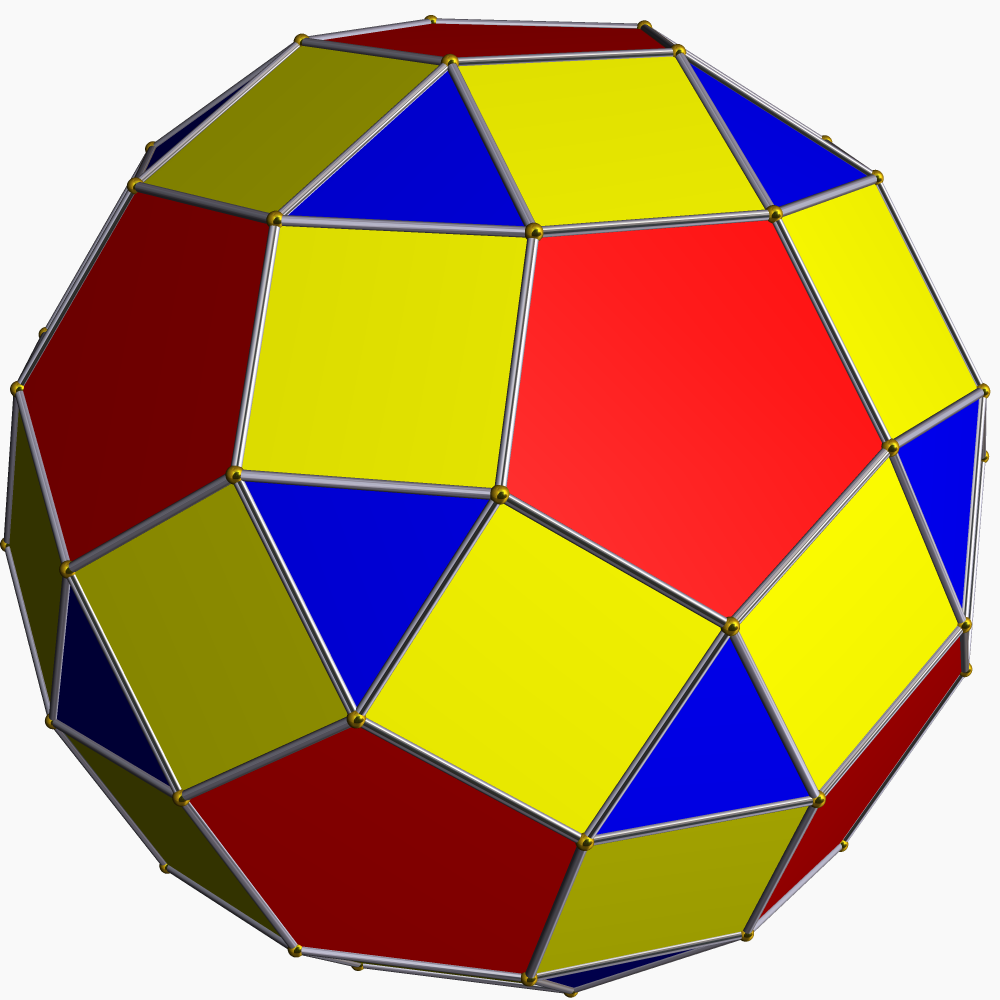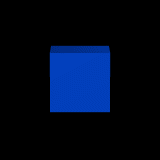|
Elongated Square Gyrobicupola
In geometry, the elongated square gyrobicupola or pseudo-rhombicuboctahedron is one of the Johnson solids (). It is not usually considered to be an Archimedean solid, even though its Face (geometry), faces consist of regular polygons that meet in the same pattern at each of its Vertex (geometry), vertices, because unlike the 13 Archimedean solids, it lacks a set of global symmetries that map every vertex to every other vertex (though Branko Grünbaum, Grünbaum has suggested it should be added to the traditional list of Archimedean solids as a 14th example). It strongly resembles, but should not be mistaken for, the rhombicuboctahedron, which ''is'' an Archimedean solid. It is also a Midsphere#Canonical polyhedron, canonical polyhedron. This shape may have been discovered by Johannes Kepler in his enumeration of the Archimedean solids, but its first clear appearance in print appears to be the work of Duncan Sommerville in 1905. It was independently rediscovered by J. C. P. Mille ... [...More Info...] [...Related Items...] OR: [Wikipedia] [Google] [Baidu] |
Johnson Solid
In geometry, a Johnson solid is a strictly convex polyhedron each face of which is a regular polygon. There is no requirement that isohedral, each face must be the same polygon, or that the same polygons join around each Vertex (geometry), vertex. An example of a Johnson solid is the square-based Pyramid (geometry), pyramid with equilateral sides (square pyramid, ); it has 1 square face and 4 triangular faces. Some authors require that the solid not be uniform polyhedron, uniform (i.e., not Platonic solid, Archimedean solid, prism (geometry), uniform prism, or uniform antiprism) before they refer to it as a “Johnson solid”. As in any strictly convex solid, at least three faces meet at every vertex, and the total of their angles is less than 360 degrees. Since a regular polygon has angles at least 60 degrees, it follows that at most five faces meet at any vertex. The pentagonal pyramid () is an example that has a degree-5 vertex. Although there is no obvious restriction tha ... [...More Info...] [...Related Items...] OR: [Wikipedia] [Google] [Baidu] |
Branko Grünbaum
Branko Grünbaum ( he, ברנקו גרונבאום; 2 October 1929 – 14 September 2018) was a Croatian-born mathematician of Jewish descentBranko Grünbaum Hrvatska enciklopedija LZMK. and a professor at the in . He received his Ph.D. in 1957 from Hebrew University of Jerusalem< ...
[...More Info...] [...Related Items...] OR: [Wikipedia] [Google] [Baidu] |
Gyrate Rhombicosidodecahedron
In geometry, the gyrate rhombicosidodecahedron is one of the Johnson solids (). It is also a canonical polyhedron. Related polyhedron It can be constructed as a rhombicosidodecahedron with one pentagonal cupola rotated through 36 degrees. They have the same faces around each vertex, but vertex configurations along the rotation become a different order, . Alternative Johnson solids, constructed by rotating different cupolae of a rhombicosidodecahedron, are: * The parabigyrate rhombicosidodecahedron () where two opposing cupolae are rotated; * The metabigyrate rhombicosidodecahedron () where two non-opposing cupolae are rotated; * And the trigyrate rhombicosidodecahedron In geometry, the trigyrate rhombicosidodecahedron is one of the Johnson solids (). It contains 20 triangles, 30 squares and 12 pentagons. It is also a Midsphere#Canonical polyhedron, canonical polyhedron. It can be constructed as a rhombicosi ... () where three cupolae are rotated. External links ... [...More Info...] [...Related Items...] OR: [Wikipedia] [Google] [Baidu] |
Square Cupola
In geometry, the square cupola, sometimes called lesser dome, is one of the Johnson solids (). It can be obtained as a slice of the rhombicuboctahedron. As in all cupolae, the base polygon has twice as many edges and vertices as the top; in this case the base polygon is an octagon. Formulae The following formulae for the circumradius, surface area, volume, and height can be used if all faces are regular, with edge length ''a'': :C=\left(\frac\sqrt\right)a\approx1.39897a, :A=\left(7+2\sqrt+\sqrt\right)a^2\approx11.56048a^2, :V=\left(1+\frac\right)a^3\approx1.94281a^3. :h = \fraca \approx 0.70711a Related polyhedra and honeycombs Other convex cupolae Dual polyhedron The dual of the square cupola has 8 triangular and 4 kite faces: Crossed square cupola The crossed square cupola is one of the nonconvex Johnson solid isomorphs, being topologically identical to the convex square cupola. It can be obtained as a slice of the nonconvex great rhombicuboctahedron or qu ... [...More Info...] [...Related Items...] OR: [Wikipedia] [Google] [Baidu] |
Pseudorhombicuboctahedron
In geometry, the elongated square gyrobicupola or pseudo-rhombicuboctahedron is one of the Johnson solids (). It is not usually considered to be an Archimedean solid, even though its faces consist of regular polygons that meet in the same pattern at each of its vertices, because unlike the 13 Archimedean solids, it lacks a set of global symmetries that map every vertex to every other vertex (though Grünbaum has suggested it should be added to the traditional list of Archimedean solids as a 14th example). It strongly resembles, but should not be mistaken for, the rhombicuboctahedron, which ''is'' an Archimedean solid. It is also a canonical polyhedron. This shape may have been discovered by Johannes Kepler in his enumeration of the Archimedean solids, but its first clear appearance in print appears to be the work of Duncan Sommerville in 1905. It was independently rediscovered by J. C. P. Miller by 1930 (by mistake while attempting to construct a model of the rhombicuboctahed ... [...More Info...] [...Related Items...] OR: [Wikipedia] [Google] [Baidu] |
Exploded Rhombicuboctahedron
An explosion is a rapid expansion in volume associated with an extreme outward release of energy, usually with the generation of high temperatures and release of high-pressure gases. Supersonic explosions created by high explosives are known as detonations and travel through shock waves. Subsonic explosions are created by low explosives through a slower combustion process known as deflagration. Causes Explosions can occur in nature due to a large influx of energy. Most natural explosions arise from volcanic or stellar processes of various sorts. Explosive volcanic eruptions occur when magma rises from below, it has very dissolved gas in it. The reduction of pressure as the magma rises and causes the gas to bubble out of solution, resulting in a rapid increase in volume. Explosions also occur as a result of impact events and in phenomena such as hydrothermal explosions (also due to volcanic processes). Explosions can also occur outside of Earth in the universe in events ... [...More Info...] [...Related Items...] OR: [Wikipedia] [Google] [Baidu] |
Small Rhombicuboctahedron
In geometry, the rhombicuboctahedron, or small rhombicuboctahedron, is a polyhedron with eight triangular, six square (geometry), square, and twelve rectangle, rectangular faces. There are 24 identical vertices, with one triangle, one square, and two rectangles meeting at each one. If all the rectangles are themselves square (equivalently, all the edges are the same length, ensuring the triangles are equilateral triangle, equilateral), it is an Archimedean solid. The polyhedron has octahedral symmetry, like the Cube (geometry), cube and octahedron. Its dual polyhedron, dual is called the deltoidal icositetrahedron or trapezoidal icositetrahedron, although its faces are not really true trapezoids. Names Johannes Kepler in Harmonices Mundi (1618) named this polyhedron a ''rhombicuboctahedron'', being short for ''truncated cuboctahedral rhombus'', with ''cuboctahedral rhombus'' being his name for a rhombic dodecahedron. There are different truncations of a rhombic dodecahedron int ... [...More Info...] [...Related Items...] OR: [Wikipedia] [Google] [Baidu] |
Prism (geometry)
In geometry, a prism is a polyhedron comprising an polygon Base (geometry), base, a second base which is a Translation (geometry), translated copy (rigidly moved without rotation) of the first, and other Face (geometry), faces, necessarily all parallelograms, joining corresponding sides of the two bases. All Cross section (geometry), cross-sections parallel to the bases are translations of the bases. Prisms are named after their bases, e.g. a prism with a pentagonal base is called a pentagonal prism. Prisms are a subclass of prismatoids. Like many basic geometric terms, the word ''prism'' () was first used in Euclid's Elements. Euclid defined the term in Book XI as “a solid figure contained by two opposite, equal and parallel planes, while the rest are parallelograms”. However, this definition has been criticized for not being specific enough in relation to the nature of the bases, which caused confusion among later geometry writers. Oblique prism An oblique prism is a pr ... [...More Info...] [...Related Items...] OR: [Wikipedia] [Google] [Baidu] |
Octagon
In geometry, an octagon (from the Greek ὀκτάγωνον ''oktágōnon'', "eight angles") is an eight-sided polygon or 8-gon. A '' regular octagon'' has Schläfli symbol and can also be constructed as a quasiregular truncated square, t, which alternates two types of edges. A truncated octagon, t is a hexadecagon, . A 3D analog of the octagon can be the rhombicuboctahedron with the triangular faces on it like the replaced edges, if one considers the octagon to be a truncated square. Properties of the general octagon The sum of all the internal angles of any octagon is 1080°. As with all polygons, the external angles total 360°. If squares are constructed all internally or all externally on the sides of an octagon, then the midpoints of the segments connecting the centers of opposite squares form a quadrilateral that is both equidiagonal and orthodiagonal (that is, whose diagonals are equal in length and at right angles to each other).Dao Thanh Oai (2015), "Equilatera ... [...More Info...] [...Related Items...] OR: [Wikipedia] [Google] [Baidu] |
Square Gyrobicupola
In geometry, the square gyrobicupola is one of the Johnson solids (). Like the square orthobicupola (), it can be obtained by joining two square cupolae () along their bases. The difference is that in this solid, the two halves are rotated 45 degrees with respect to one another. The ''square gyrobicupola'' is the second in an infinite set of gyrobicupolae. Related to the square gyrobicupola is the elongated square gyrobicupola. This polyhedron is created when an octagonal prism is inserted between the two halves of the square gyrobicupola. It is argued whether or not the elongated square gyrobicupola is an Archimedean solid because, although it meets every other standard necessary to be an Archimedean solid, it is not highly symmetric. Formulae The following formulae for volume and surface area can be used if all faces are regular, with edge length ''a'': :V=\left(2+\frac\right)a^3\approx3.88562...a^3 :A=2\left(5+\sqrt\right)a^2\approx13.4641...a^2 Related polyhedra and h ... [...More Info...] [...Related Items...] OR: [Wikipedia] [Google] [Baidu] |
Duncan Sommerville
Duncan MacLaren Young Sommerville (1879–1934) was a Scottish mathematician and astronomer. He compiled a bibliography on non-Euclidean geometry and also wrote a leading textbook in that field. He also wrote ''Introduction to the Geometry of N Dimensions'', advancing the study of polytopes. He was a co-founder and the first secretary of the New Zealand Astronomical Society. Sommerville was also an accomplished watercolourist, producing a series New Zealand landscapes. The middle name 'MacLaren' is spelt using the old orthography M'Laren in some sources, for example the records of the Royal Society of Edinburgh. Early life Sommerville was born on 24 November 1879 in Beawar in India, where his father the Rev Dr James Sommerville, was employed as a missionary by the United Presbyterian Church of Scotland. His father had been responsible for establishing the hospital at Jodhpur, Rajputana. The family returned home to Perth, Scotland, where Duncan spent 4 years at a private sc ... [...More Info...] [...Related Items...] OR: [Wikipedia] [Google] [Baidu] |



